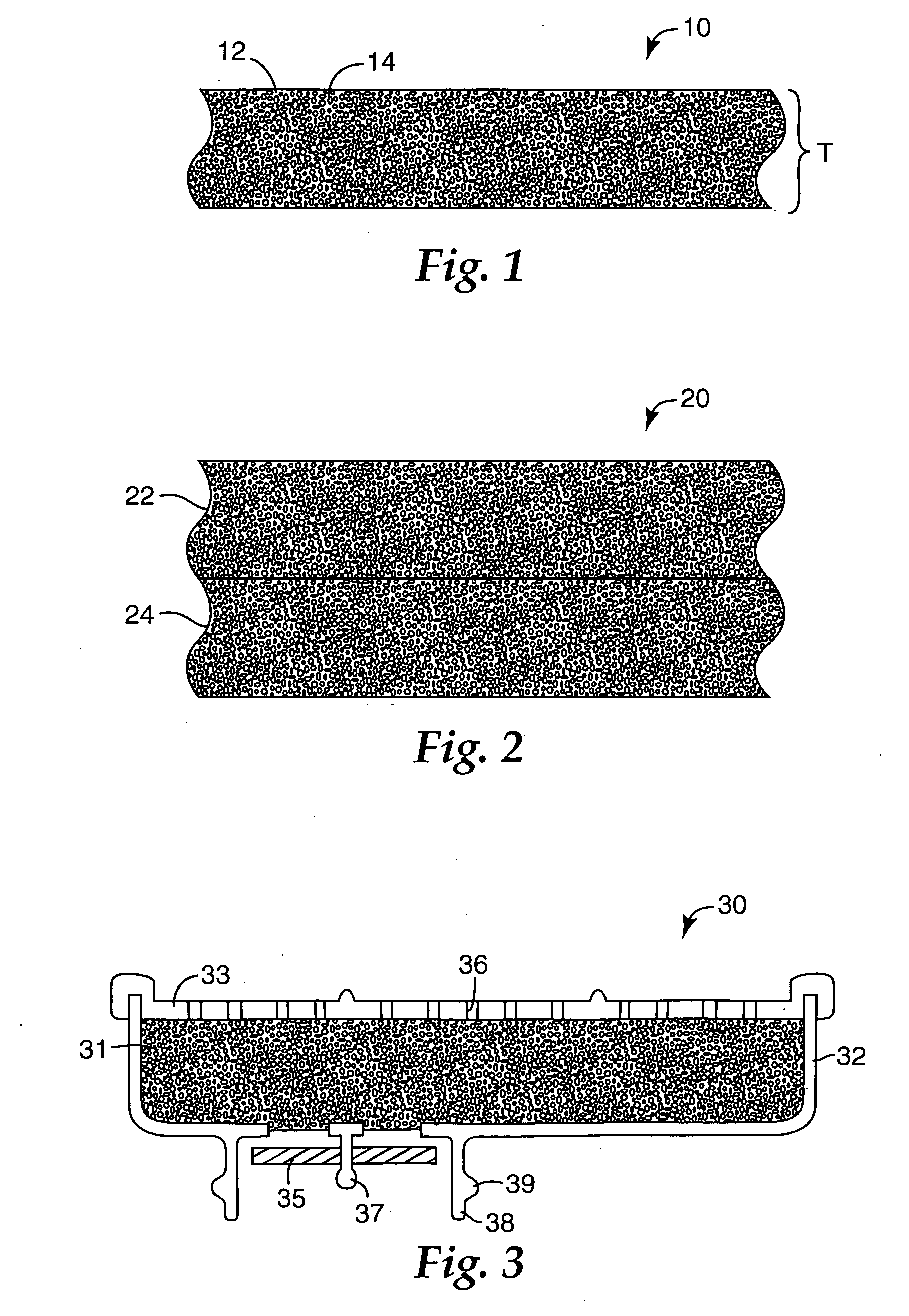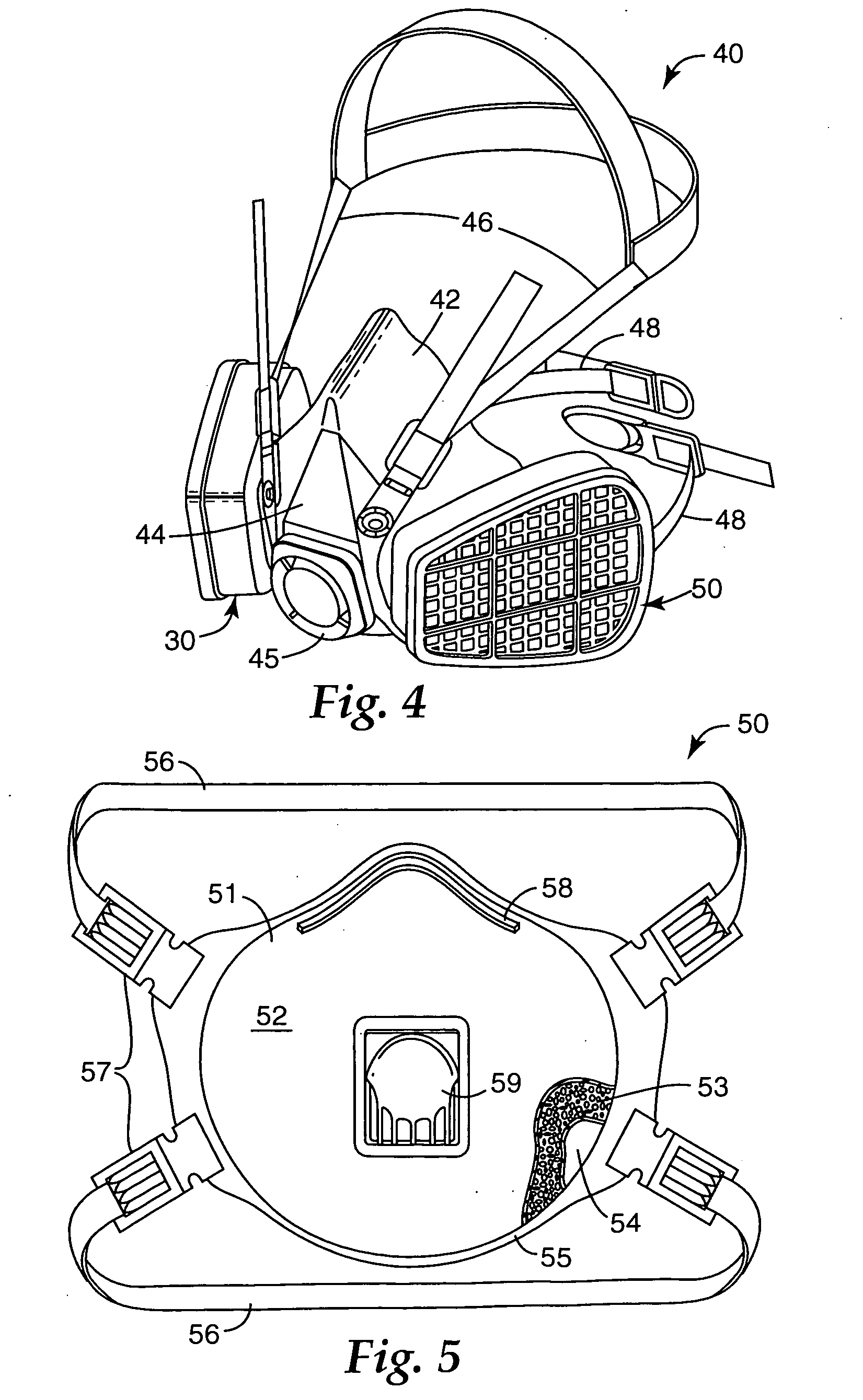Particle-containing fibrous web
a technology of fibrous webs and fibrous fibers, which is applied in the direction of cellulosic plastic layered products, separation processes, breathing protection, etc., can solve the problems of difficult to handle the web in a production environment, the cartridge may not contain enough activated carbon to meet the capacity requirements of applicable standards-making bodies, and the web may not be replaced with enough activated carbon to meet the capacity requirements. , to achieve the effect of low carbon shedding, low pressure drop, and high service li
- Summary
- Abstract
- Description
- Claims
- Application Information
AI Technical Summary
Benefits of technology
Problems solved by technology
Method used
Image
Examples
example 1
[0072] Using a meltblowing apparatus with a single horizontal stream of filaments like that shown in FIG. 6, a 230-300° C. polymer melt temperature (depending on the polymer and desired fiber size), a drilled orifice die and a 32 cm die-to-collector distance, a series of meltblown carbon-loaded nonwoven webs was prepared using various fiber-forming polymeric materials extruded at about 300 g / hour / cm of die width for the thermoplastic polyurethane used in Run No. 2 (see Table 1, shown below) and about 230 g / hour / cm of die width for the remaining polymeric materials shown in Table 1. The extruder temperature and air velocity (and as needed, other processing parameters) were adjusted to obtain webs having about a 16 to 29 micrometer effective fiber diameter (“EFD”), with most of the webs having about a 20 to 29 micrometer EFD. EFD values were determined using an air flow rate of 32 L / min (corresponding to a face velocity of 5.3 cm / sec) according to the method set forth in Davies, C. N....
example 2
[0078] A variety of thermoplastic polymers were formed into discs by pressing extrusion grade pellets as received from the polymer manufacturer in a heated laboratory hydraulic press (available from Carver, Inc.). The press was equipped with stainless steel platens covered with polytetrafluoroethylene liners. A bump stop made from 0.5 mm feeler gauge stock was employed to regulate the disc thickness. The press temperature was varied depending on the particular polymer being pressed but generally was set to about 200-250° C. Pressures of about 207 kPa and pressing times of about 15 seconds were employed. The resulting resin coupons were folded and repressed until air gaps and other imperfections were removed, to provide discs with target dimensions of about 50 mm diameter and 0.5 mm thickness. The discs were placed in a desiccator and arranged for even exposure to the desiccator internal atmosphere. Sufficient DMMP to provide a saturated internal atmosphere was also placed in the des...
PUM
| Property | Measurement | Unit |
|---|---|---|
| Percent by mass | aaaaa | aaaaa |
| Percent by mass | aaaaa | aaaaa |
| Percent by mass | aaaaa | aaaaa |
Abstract
Description
Claims
Application Information
 Login to View More
Login to View More - R&D
- Intellectual Property
- Life Sciences
- Materials
- Tech Scout
- Unparalleled Data Quality
- Higher Quality Content
- 60% Fewer Hallucinations
Browse by: Latest US Patents, China's latest patents, Technical Efficacy Thesaurus, Application Domain, Technology Topic, Popular Technical Reports.
© 2025 PatSnap. All rights reserved.Legal|Privacy policy|Modern Slavery Act Transparency Statement|Sitemap|About US| Contact US: help@patsnap.com



